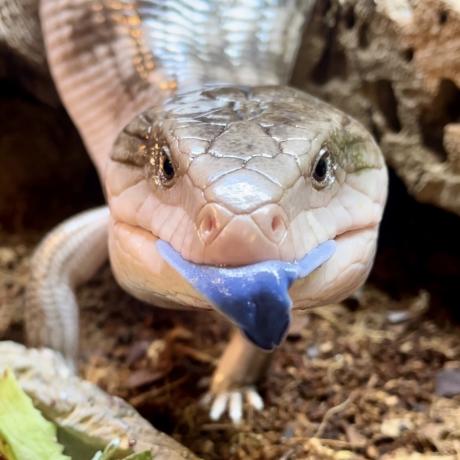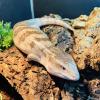

The name Blue Tongue Skink comes from the colour of this skinks tongue, which is berry blue. They are a large species which can reach sizes of 50cm (20in).
| Origin | Australia, Indonesia, New Guinea |
|---|---|
| Environment | Woodlands, Semi-Desert |
| Adult Size | 50cm |
| Suitability | Beginner |
| Lifespan | 12 Years + |
| Temperament | Docile |

They are a typical looking skink with a heavy built broad body with small legs. Their head is blunt, broad and triangular and they have a berry blue tongue with a deep pink interior mouth. Blue Tongue Skinks have a light brown/grey background colour with dark mottled coloured bands across the width of the body.
Newly born Blue Tongue Skinks can measure 15cm (6in) in length. Adults reach lengths of 50cm (20in) from head to tip of tail.
They can be found living in open woodlands, at the margins of forest and semi-deserts in Australia, Tasmania, and New Guinea.
A Vivarium of 48x15x15in is required for one adult pair of Blue Tongue Skinks. You should provide a dry woodland type enclosure with Orchid Bark for the flooring. Cork Bark and other hides should be provided with some artificial plants. The use of a 5% UV light should be provided. Although some people say that these Skinks do not need this, they would benefit from it. Provide a daytime temperature of 25-35C (77-95F) with a drop down to 18-20C (65-68F) during the night. Use a heat mat and a thermostatically controlled spotlight on one side of the enclosure and place a shallow water dish at the other side.
Blue Tongue Skinks are omnivores, meaning they eat both plant and animal matter. It’s best to place the food in a dish, this helps keep the enclosure clean, but Blue Tongue Skinks like to actively search for their food. Offer your adult skink fresh food every three days. Younger skinks should be offered food ad lib, meaning however much they will eat, this will reduce as they grow. Any un-eaten food should be removed within 24hr especially meat.
Please see a list of the Blue Tongue Skinks food: